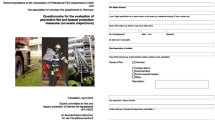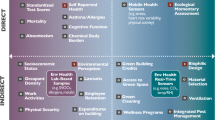Abstract
Objectives: The aim was to study relationships between symptoms compatible with sick building syndrome (SBS) on one hand, and different indicators of building dampness in Swedish multi-family buildings on the other. Methods: In Stockholm, 609 multi-family buildings with 14,235 dwellings were identified, and selected by stratified random sampling. The response rate was 77%. Information on weekly symptoms, age, gender, population density in the apartment, water leakage during the past 5 years, mouldy odour, condensation on windows, and high air humidity in the bathroom was assessed by a postal questionnaire. In addition, independent information on building characteristics was gathered from the building owners, and the central building register in Stockholm. Multiple logistic regression analysis was applied, and adjusted odds ratios (OR) were calculated, adjusted for age and gender, population density, and selected building characteristics. Results: Condensation on windows, high air humidity in the bathroom, mouldy odour, and water leakage was reported from 9.0%, 12.4%, 7.7% and 12.7% of the dwellings, respectively. In total 28.5% reported at least one sign of dampness. All indicators of dampness were related to an increase of all types of symptoms, significant even when adjusted for age, gender, population density, type of ventilation system, and ownership of the building. A combination of mouldy odour and signs of high air humidity was related to an increased occurrence of all types of symptoms (OR=3.7–6.0). Similar findings were observed for a combination of mouldy odour and structural building dampness (water leakage) (OR=2.9–5.2). In addition, a dose-response relationship between symptoms and number of signs of dampness was observed. In dwellings with all four dampness indicators, OR was 6.5, 7.1, 19.9, 5.8, 6.1, 9.4, 15.0 for ocular, nasal, throat, dermal symptoms, cough, headache and tiredness, respectively. Conclusion: Signs of high air humidity, as well as of structural building dampness, are common in multi-family buildings in Stockholm. Reports of building dampness in dwellings is related to a pronounced increase of symptoms compatible with the SBS, even when adjusted for possible confounding by age, gender, population density, and building-related risk factors.
Similar content being viewed by others
Author information
Authors and Affiliations
Additional information
Received: 10 April 2000 / Accepted: 10 November 2000
Rights and permissions
About this article
Cite this article
Engvall, K., Norrby, C. & Norbäck, D. Sick building syndrome in relation to building dampness in multi-family residential buildings in Stockholm. Int Arch Occup Environ Health 74, 270–278 (2001). https://doi.org/10.1007/s004200000218
Issue Date:
DOI: https://doi.org/10.1007/s004200000218




